Basic kidney stone diet:
Almost all kidney stone patients will benefit from simple dietary changes which include increasing their fluid intake and limiting certain types of food. Together, these simple steps have been shown to decrease the risk of forming another stone by 50% or more and will also improve overall health and well-being. A handout outlining these steps is available for download below. For more detailed information on dietary prevention read on further.
A high fluid intake is one of the most important cornerstones of kidney stone dietary prevention. A sufficiently dilute urine will prevent the individual chemical components of stones from becoming concentrated enough to precipitate out of solution, keeping them instead in their dissolved state. A high urine output also may reduce stone from forming through “flushing” out of stone components and prevention of urine stagnation. In addition to stone benefits, increased water intake has been shown to have a multitude of other benefits, including improved alertness, better skin appearance, enhanced physical performance, reduced constipation, and enhanced weight loss.
The average daily urine output of normal healthy adults is 1.2 liters a day, ranging from 1 to 2 liters in most individuals and varying with body weight and gender. In stone formers, however, a higher daily urine output is required for stone prevention and achieving a daily volume of at least 2.0 to 2.5 liters a day can significantly reduce the recurrence of future stones. In a randomized study of stone formers who were given specific instructions to increase their fluid intake compared to stone formers told to not change their diet, those given specific fluid instructions achieved a high urine output of 2.6 liters a day versus 1.0 liters a day in those not given dietary instructions. Over a period of five years, the high fluid intake group was half as likely to form new stones as compared to the normal fluid intake group (Borghi et al, J Urol 1996).
We recommend that most stone formers increase their daily fluid intake by one liter (an additional two 16 oz water bottles or two tall glasses a day) in order to achieve a urine output of 2.5 liters a day. (One liter = 4.2 8-oz glasses or 34 oz).Alternatively, a 24 hour urine collection can be performed to guide fluid intake to achieve 2.5 liters of urine output in a specific patient.
Type of fluid intake
The type of fluid intake is generally less important that the total intake. While drinking water is our preferred recommendation because it is inexpensive and contains no calories, for stone patients who do not enjoy drinking water, any beverage will be beneficial in reducing stone risk.
Contrary to popular belief, studies have found that an increased intake of tea, coffee, and alcoholic beverage actually reduces the risk of stones, possibly because of an associated increase in urine output (Curhan et al, Am J of Epidemiology, 1996). While tea contains high levels of oxalate, this does not appear to result in increased stone formation for the reasons discussed below in our discussion on oxalate.
Soda intake (including colas) and milk intake also do not appear to increase the risk of stones.
 Citrus juices, including lemon juice and orange juice, contain citrate, which acts as a stone inhibitor for calcium based stones. Citrate seems to do this by binding calcium, making it unavailable to combine with oxalate or phosphate: a necessary first step in the formation of stones. Citrate also seems to make it more difficult for stones to grow once they’ve formed.
Citrus juices, including lemon juice and orange juice, contain citrate, which acts as a stone inhibitor for calcium based stones. Citrate seems to do this by binding calcium, making it unavailable to combine with oxalate or phosphate: a necessary first step in the formation of stones. Citrate also seems to make it more difficult for stones to grow once they’ve formed.
Drinking citrus juice in the form of concentrated lemon juice mixed with water has been shown to effectively increase urinary citrate levels and reduce urinary calcium levels, both of which will reduce stone risk. Orange juice will similarly increase urinary citrate levels. However, orange juice appears to also increase urinary oxalate levels (a stone promoter). Other sources of citrate, including grapefruit juice, have had less research completed confirming their beneficial effects on urinary citrate levels. Therefore, lemon juice is typically favored over other citrus juices as a natural method to increase urinary citrate levels. Many patients find drinking citrus juices to be an attractive alternative to pharmaceutical treatment with potassium citrate.
We recommend that stone formers consider supplementing their daily fluid intake with a mixture of 60 ml of concentrated lemon juice in one liter of water to increase their urinary citrate levels.
 A high sodium intake increases the risk of stone formation by increasing calcium levels and decreasing citrate (a stone inhibitor) levels in urine. Additionally, high sodium intake will impair the ability of medications such as hydrochlorothiazide to effectively reduce calcium levels in urine. A study of stone formers who were kept on a strict diet with a maximum daily sodium intake of 50 mmol (1200 mg) in addition to a reduced protein diet demonstrated that the low sodium diet was effective in reducing stone recurrence by 50% as compared to the low calcium diet.
A high sodium intake increases the risk of stone formation by increasing calcium levels and decreasing citrate (a stone inhibitor) levels in urine. Additionally, high sodium intake will impair the ability of medications such as hydrochlorothiazide to effectively reduce calcium levels in urine. A study of stone formers who were kept on a strict diet with a maximum daily sodium intake of 50 mmol (1200 mg) in addition to a reduced protein diet demonstrated that the low sodium diet was effective in reducing stone recurrence by 50% as compared to the low calcium diet.
We recommend that stone formers aim to follow the FDA’s guideline of limiting salt intake to 2300 mg of sodium a day in the general population and 1500 mg of sodium a day in those with hypertension, African Americans, or middle aged and older adults. 2300 mg is equivalent to about 1 teaspoon of table salt.
The best way to determine the salt content of your food is to read the nutrition label. Processed foods tend to contain higher amounts of salt. Choose low sodium options whenever possible.
- 1 cup of canned chicken noodle soup contains 870 mg of sodium
- A fried chicken drumstick contains 310 mg of sodium
- A serving of shrimp contains 240 mg of sodium
- 2 slices of white bread contains 200 mg of sodium
- 15 potato chips contain 180 mg of sodium
- 1 container of strawberry yogurt contains 85 mg of sodium
- 1 tomato contains 20 mg of sodium
- 1 apple contains 0 mg of sodium
In addition to lowering the risk of stones, a low sodium intake helps to control or prevent high blood pressure, which can lead to heart disease, stroke, heart failure, and kidney disease.
Animal protein in meat products increases the risk of stone by increasing calcium, oxalate, and uric acid levels in urine. All three of these changes increase the risk of stones. In studies comparing high meat eaters versus low meat eaters, high meat eaters were found to be at increased risk of forming stones. A randomized study of stone formers restricted to a low meat intake of 52 grams a day (equivalent to 8 0z of beef) in combination with sodium restriction found that the combination reduced stone recurrence by 50% compared to calcium restriction alone (Borghi et al, NEJM 2002).
We recommend that most stone formers try to reduce their meat intake to 6 oz a day. This includes all types of meat: beef, pork, poultry, and seafood.
The USDA recommends a daily allowance of 5-6 oz of protein intake among adults. They also recommend choosing non-meat protein foods such as nuts and beans instead of meat sources. Protein from non-meat sources does not appear to increase the risk of stones.
- A small steak contains about 3-4 oz of protein.
- A quarter pound hamburger with cheese contains 4 oz of protein.
- A chicken breast contains about 5 oz of protein, a chicken thigh about 2.5 oz, a chicken drumstick about 1.5 oz.
- One 5 oz can of tuna contains 5 oz of protein.
- 1 medium egg contains 1 oz of protein.
Lowering your animal protein intake and eating more fruits and vegetables also benefits your overall health by limiting the amount of saturated fats and cholesterol in your diet. This helps to reduce your risk of cardiovascular disease.
While oxalate plays an important role in the development of calcium oxalate stones, dietary restriction does not appear to be effective in reducing the risk of stones in the majority of patients. About 40% of urinary oxalate comes from dietary sources while the remainder is naturally made within the liver. Therefore, reducing oxalate dietary intake does not always have a significant impact on total urinary oxalate levels.
Oxalate is found in many vegetable and fruits, including many healthy dietary choices often making it difficult to achieve a low oxalate diet. Because of these issues, oxalate avoidance is beneficial primarily in those individuals with specific abnormalities that lead to high oxalate urinary levels.
We recommend that most stone formers should maintain a normal oxalate intake without the need for oxalate restriction. High oxalate intake should be avoided in individuals found to have high urinary oxalate levels on metabolic evaluation. Oxalate restriction may be beneficial in certain individuals with high urinary oxalate levels.
Oxalate rich foods
- Tea (black)
- Spinach
- Mustard greens
- Chard
- Beets
- Rhubarb
- Okra
- Berries
- Chocolate
- Nuts
- Sweet potatoes
Kidney stone formers often question whether to stop or reduce their calcium intake. Despite the fact that calcium is a major component of 75% of stones, excessive calcium intake is very rarely the cause of stone formation. In fact, several studies have shown that restricting calcium intake in most stone formers actually increases the number of stones they develop. This appears to happen because when less calcium is ingested, it becomes easier for oxalate (which normally binds with calcium in the gut) to be absorbed. Higher levels of oxalate in the urine then lead to an increase in stone risk. Calcium obtained from dietary sources appears to be better than calcium from supplements in regards to lowering stone risk because supplements can actually increase your risk of stones slightly (by 17%) while dietary calcium intake is instead associated with lower stone risk. If you need to take supplements, taking them during meals appears to be better in terms of stone risk.
We recommend that stone formers maintain a normal calcium intake, preferably from dietary sources. Female stone formers taking calcium supplementation to prevent osteoporosis experience a slightly increased risk of stones (17%) which needs to be balanced against their risk of osteoporosis.
For more on calcium intake and stones, see: Should I stop my calcium?
Editors note: Oxalate and calcium sections updated on 5/23/12 to reflect information presented at the 2012 American Urological Association Meeting.







It would be so nice if this website could do a forum section where we could speak freely about this awful thing. After what I went through with an 8mm stone I am shocked that there are not forums all over the web for kidney stones. Maybe stones are rare or people just want to forget about it and go on with their life. There are zero active forums on Kidney Stones! I got my first stone at 47 and I hope it is the last. For those of you who get these things all the time, how do you do it? Not just the pain but the cost. I have the best insurance in the US and it still cost me $1,200! Not to mention the “what-ifs” and worry on future stones. Someone, please start a forum!
Hello Derek, I had a 12mm stone removed on the 13 October by Ureteroscopy, my first pee at the hospital was a big shock, it was like peeing broken glass coupled with lots of blood, im 54 and this is my 3rd bout of stones, I still have a 3mm on in my other kidney which hopefully I can pass naturally. The pain of kidney stones is pretty bad as you know but a week later I feel much better and im passing urine ok but its not the same flow pressure as before, im told this is natural and will gradually revert back to normal. I live in England so thanks to the NHS its not cost me a penny, mid you I met a lady at a stone clinic who has suffered with stones all her life and to date has passed or had removed 96 stones, I felt quite insignificant ….but I agree a forum would be a great idea, take care. Paul.
Please get a referral to a nephrologist. A kidney specialist. They can tell you what your stones are made of and the best way to treat them. I have had numerous stones since 2000. They run in my family. Since I started seeing my nephrologist they have slowed dramatically. There is no magic cure if you are stone former then see a kidney doctor.
Hi my name is lakhan from india 5mm stone in my urinnary bladder pls advice me how to reduce stone size
I have had two stones that had to be dealt with because they both got stuck. The first one was cared for by lithotripsy. The stent placed for that one was HORRIBLE/painful. I hated it and it was impossible to work or do anything with it in. Last fall I started having symptoms of UTI and other vague symptoms. Eventually my general practitioner said, “Well, let’s wait and see what happens.” What happened was the cramping and pain got so bad I ended up in the ER where it was found I had a large stone stuck high in the bladder. I was so sick by that time the Urologist hospitalized me overnight until he could do surgery the next day. They went after this one with a scope under general anesthesia. The good news, it was almost impossible to feel this stent and I was much more comfortable. I still have several small stones in my right kidney and now a new diagnosis of a condition of sensitive and irritable bladder wall made worse by certain foods and beverages. Trying to figure out dietary issues right now is my biggest challenge and very confusing. Appreciate this website and knowing I’m not alone.
I’ve read about possible home remedies for kidney stones, both preventing and breaking them up once they form. One was the lemon juice mixed with water mentioned here. I’ve also seen cranberry juice, beet juice (despite its listing here as oxylate-rich), magnesium and B6 tablets, and various teas – corn silk, juniper, watercress or uva ursi. Can anyone confirm or deny whether any of these actually help? Thanks.
The lemon juice in water will definitely raise your citrate level and that will help to prevent calcium binding.
Hiii
friends plz halp me my right kidany 7.5 mm stone you will plz help me and sejested to aayurvedik medisin
Hey there. Please help me. I am from the Philippines, 26 years of age and has a 1.01cm kidney stone in my left kidney. Any tips? Please. Thanks. Im too young. I am so afraid, my father just died on 2013 due ro renal failure. 🙁
Hi,
My dad has a mild stone in ureter, he z diabetic too, though it pains continuously, but the issue is his loss of appetite ,just want to know is that normal ?
I’ve read here that Hard Water causes kidney stones is a myth. My urologist seemed kind of on the fence, he said it isn’t proven and there isn’t much to go on, but agreed that up until a certain point it could be possible. He didn’t have any proof just his opinion, and I tend to agree. Studies can be done but unless exact levels are matched as compared to the tests, anything over might be an entirely new category. Maybe my water is so hard it is causing problems.
Regardless, since I’m only staying in my apartment for another couple of months, I’ll probably switch to bottled water and lemon juice just to be safe on top of adjusting my diet a bit.
I have two 0.4cm size kidney stones, is this very dangerous?
A 0.4cm, or 4 mm, stone is not dangerous, but can be painful while passing.
I have multiple stones in both kidneys, they are usually approx 4mm or smaller. The really tiny stones aren’t bad to pass, but passing a 4mm stone can definitely be painful. They aren’t dangerous though. I usually haven’t had to do anything to my stones unless they are 6mm or more, and then they give me a short wave lithotripsy to bust them up – or more like pulverize them so that I can pass them without the risk of them getting stuck (which I’ve also experienced twice and had to have them removed – now those are the worst in my opinion)!
Lol yes the ones that get stuck are definitely the worst!.. I just had a stent put in today because of one. No fun whatsoever!
I am having 11mm stent in the left ureter what diet i should refer n what treatment
So helpful to read all this to not feel so alone. 1 week ago I had a stent removed after a ureteroscopy to remove my first 7 mm stone – stuck at end of ureter by the bladder. BUT once dr. was at the site with a scope, the stone was gone so he went up into my kidney with the scope and grabbed a small stone to send out for analysis. It is partially the common calcium kind and partially the uncommon calcium kind. I was so delirious from the stent removal pain I was not very clear re type. Now 1 week later, I suddenly have pain again and some blood in the urine. I fear it is a new stone. Is this freaking possible? Or just a sign I overdid it my first full day on my feet? This whole experience has been painful and confusing with the only clarity coming from other “stoners.” Has anyone had a similar week after stent experience of new pain and new blood in the urine?
I just had lithroscopy for a 9mm stone 2 weeks ago.I too had a stent. I haven’t had any problems since it was removed.You should go see your doctor. Good luck! I swear I’m suffering from PTSD from that two weeks of hell!
I was in incredible pain for weeks. The doctor gave me antibiotics and said I had a bladder infection. Two weeks later the blood was still there. I called my urologist and it took another 2 weeks to see him. Then another 10 days to schedule the ureteroscopy. I just had my stent removed after 2 weeks. This was my second ureteroscopy in 2 years. The pain was different this time so I thought maybe it was a bladder infection. I had to work those 2 weeks with the stent. I stayed home the day of the procedure and the next day. I was in incredible pain. I hate the stent. I am more miserable with the stent than the stones. At least the pain meds help the stone pain. NOTHING helps the pain from the stent. The stent was removed 2 days ago. After about 4 hours the pain from the stent had greatly improved. I hope you called your doctor about the pain after the stent was removed.
Hey Guys,
The Best way to remove all kind of stones either in kidney or in urinary bladder or anywhere is to take Arq of Balam Kheera(Kigelia){http://en.wikipedia.org/wiki/Kigelia}
I Don’t know where you will it but its ayurvedic medicine which has no side effects really.
I got bladder stone out in just half night and kidney stone in one month(with much fluids). Just need to take 2-3 tablespoons in half glass of water(25-50ml). It Dissolves the stones. It’s a God Gift, better than anything. God is the best Doctor. If you find anywhere near by you hanging from tree after pick just beat it something and with a cotton cloth covered on it, press it, The fluid is Arq of balam kheera. You may can get it from some ayurvedic store. just remeber it is very sour(fake are there on shops in Delhi).
This is invalid. See the scientific study at this web address: http://pelagiaresearchlibrary.com/asian-journal-of-plant-science/vol2-iss1/AJPSR-2012-2-1-63-72.pdf
Read your link.The research says it works. Here is the Conclusion
Why do u say its invalid
CONCLUSION
The aim of the study was to assess the antiurolithic activity of ethanolic extract of Kigelia pinnata fruit on ethylene glycol induced hyperoxaluria model in Wistar male rats. Antiurolithic activity of Kigelia pinnata fruit extract was confirmed by measuring the serum marker (creatinine and uric acid), tissue homogenate marker (calcium, oxalate and phosphate), urinary parameter (calcium, oxalate, phosphate, uric acid and magnesium) and urinary output and thus it significant reduced and prevented the growth of urinary stones. These studies supported the folk information regarding antiurolithic activity of the plant.
Hi i’ve learnt a lot through your comment, me too i have kidney stone and gallbaldder stone but it passed out by drinking plenty of water and apple cider vinegar contains the ‘mother’ organic daily before breakfast or squeeze1 fresh lemon in half glass of water add 1tab spoon of apple cider vinegar as mentionned above but lots of water is required, coconut water finally by the lord it disappeared then i have small ones again then through search i’ve done on medical magazines i eat cheese daily so i better go on dieting where cheesy things matters lol i start it from now i already havedj stent placed now with proper medication and diet and some exercise i’m confident i will passed it out
Hi.. The experiences people are sharing here seems quite helpful. I want to share my part too.
I’m 22 years old. I’m into the third week of having a stent inside my ureter. I’ve a huge 15 mm sized calculus. Initially, the pain was unbearable but after i was hospitalized and suggested medication, things have been under control. I still get the occasional attacks though, for which I need to keep a particular medicine beforehand. I’m gonna go for ESWL in a couple of weeks.
PS, ESWL delayed because of exams (Consequences of being an engineering student…LOL) 🙂
Take a lotta fluids, guys….. and take care 🙂
actually I am suffering from kedney stone,b its to much minor in sonography,, so dr said dat it wikll be removed by medicines…
b t i am afraid abt dat it wll nt happened in future with me,,,
so plz suggest me something to avoiid dat….
Hello readers.
I’m from India and 49 yrs of age. I’m a chronic stone former since 1991. I’ve had eight occurrences of calcium oxalate calculi formed till date. The latest one being 10mm, removed by pcnl on 1st Oct.
What I want to inform is that a stent was placed as a routine matter, but it developed an infection in me, which was so severe, that I ran a high fever of 105 along with shivering and this dehydrated me and nearly took my life!!!
I was hospitalized for over eight days and I don’t know how many more days it’ll take for me to gain normal strength. So do becarefull about how many days you let the stent be in your body. Mine rejected a foreign body in it violently. Will yours accept it?
This has happened to me as well. I’m glad you pulled through, as did I obviously. This was one of the scariest moments of my life. Now every time I get a kidney stone, or even a UTI, I am scared to death my body is going to go septic and my kidney is going to shut down. It has been very traumatic.
I really appreciate all the helpful information being shared here. I was looking for something on the negative effects of ESWL, as I’m scheduled for ablation of a 1.2cm stone. At age 65 I’m concerned about damaging my kidneys and surrounding organs. I was very interested to learn about Chanca Piedra, as I’d love to find an alternative treatment to ESWL So I looked it up and read the product information and reviews. Unfortunately, I just can’t really believe an herbal remedy can break up my kidney stones – at least not within hours-days-weeks, as described in the product reviews. That said, I do believe I might try it for pain the next time I’m passing a stone.
Based on my 5-years experience passing stones, here are some things that might help someone better understand this condition: There are different types of stones – and patients. Some stones break up more easily than others. Some people have larger urethra and pass stones more easily. Men typically have more pain and difficulty passing stones, and shouldn’t delay getting medical attention. Stones often break-up entirely on their own; and yes – water consumption, diet, medication and supplements all can have an effect – both positive and negative. Finally, before having ESWL, do read the information published on the National Institutes of Health web site and task your urologist to apply their recommendations.
Good luck with the ESWL! I had to have that a few years ago for a 1cm stone, and I was terrified beforehand. But it went well and it was definitely preferable to passing the stone myself. My side did feel bruised and tender for a few days afterwards, but that disappeared quickly and I haven’t had any long term damage.
Today I found out I’ve formed another stone, though I haven’t been told how big it is yet (I’ll find out tomorrow). I’ve had pain for about a week now and have blood in my urine, so I’m a little scared it’s not passing on its own and I might need ESWL again. In the mean time, all I can do is keep drinking lots of fluids and hope that it gets flushed out. But worst case scenario, I’ll definitely consider ESWL again if it’s an option.
Garet — I read that you mix 1/2 cup lemon juice w/7 cups water
Re Lemon water. Can someone please give a definitive answer as to exactly how much real lemon juice equals 60mls concentrate? I have lemons growing in the garden, and googling produces varying answers.
Thank you.
From what i’ve been reading, magnesium seems to play a role in preventing stones. Can anyone confirm? Could stones be a result …not of too much calcium or oxalate, but rather of too LITTLE magnesium?
I have Calcium Phosphate stones and my acupuncturist STRONGLY recommended magnesium along with my urologist. I have a powder form that I sprinkle in my food and some drinks. The key is a little bit, 1/2 tsp or less, multiple times per day. Like with any mineral if you take to much at a time your body will flush it out and then you won’t get the benefit.
I read something similar about magnesium potentially helping to prevent certain types of kidney stones (in this case potassium magnesium citrate):
http://www.ncbi.nlm.nih.gov/pmc/articles/PMC4064051/
Has anyone had success taking magnesium?
In regards to calcium intake my urologist advised me to continue to eat/drink just not eat/drink calcium rich foods and beverages on their own. For instance don’t just eat a yogurt but have something else with it.
hi ..
i am suffering with bilateral kidney stone with haematuria . the stone size is 7mm and 6mm left kidney has few calculi and right kidney shows multiple calculi..Moreover presence of stone in the ureter cause hydroureteronephrosis and lymhocyte count has reduced to 22.. what treatment i want to take ..plz help me …. iam 26 years old…
I appcreiate you taking to time to contribute That’s very helpful.
Working on passing my 11th stone. Has anyone been referred to an endocrinologist to see if you have primary hyperparathryoidism ? Currently being evaluated since I have stones, HBP, osteoporosis, high levels of urine calcium. If you can find out the underlying cause, rather than being told iced tea caused your stones (as I was told) when in fact I leak calcium into my kidneys that is being pulled from my bones, then maybe we can all get relief, maybe not an overall cure,but the true reason. I suggest a nephrologist or endocrinologist.
I had primary hyperparathyroidism (and successful surgery to remove the one adenoma). This was picked up by regular blood work – my calcium was high and vitamin D was low, so my (general practitioner) doctor ordered PTH (paraythyroid hormone) blood work which conclusively diagnosed me. Surgery was with Dr. Michael Yeh at UCLA Medical Group, and his team was awesome. If you might have it, you want it diagnosed and cured immediately, because there are really awful long term implications with it. Good luck!
Have you viewed the website http://www.parathyroid.com/parathyroid.htm ? It is most informative and hopeful.
Please see my comment under stent insertion and removal pages about Chanca Piedra herbal compound to break up large stones and pulverize small ones. My husband has a 6.8mm stone and a stent, and is starting his 3rd week of the compound. He does not have pain except occasional and brief and is not having to take heavy duty meds, so that makes a difference. However the compound is routinely used as a preventative or when the first little twinge is felt. Look up the compound on Amazon and read the patient reviews. It is inexpensive and appears to have no bad side effects. .